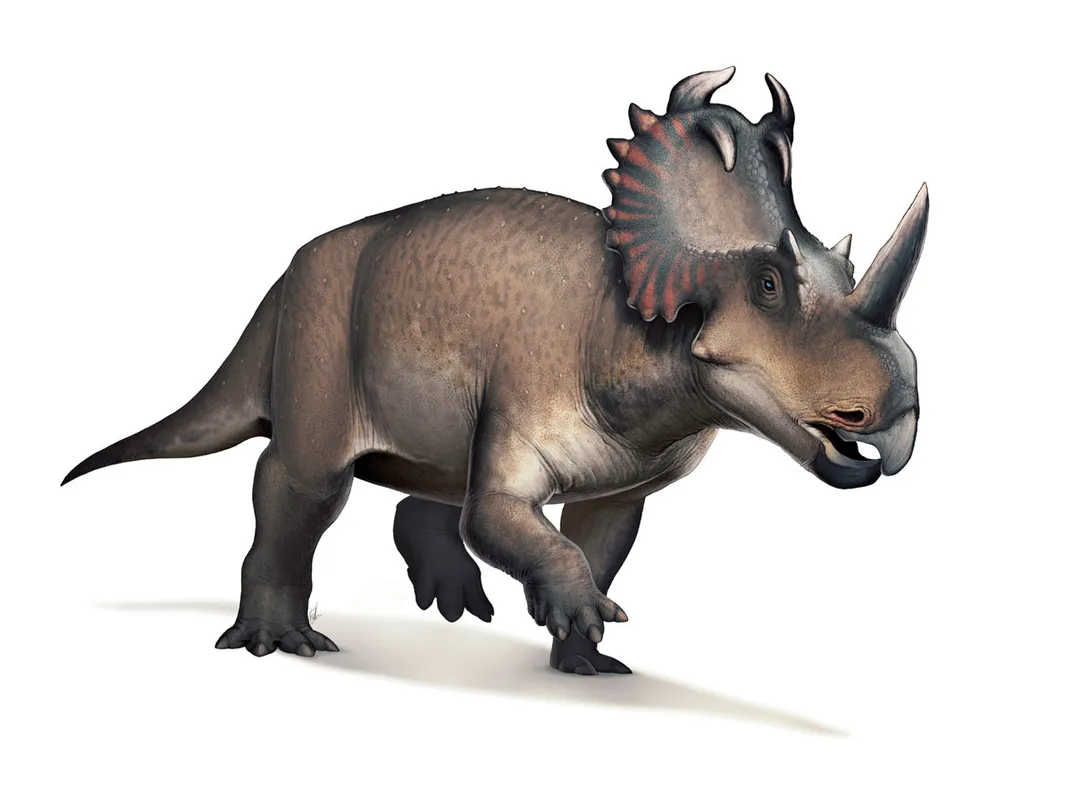Dinosaurs Suffered From Cancer, Too
A bone containing signs of cancer is the first of its kind found in the fossil record
:focal(445x628:446x629)/https://tf-cmsv2-smithsonianmag-media.s3.amazonaws.com/filer/fe/51/fe513b49-8de1-4777-9326-90bb79866eae/img_6190_web.jpg)
In most cases, paleontologists are at least 66 million years too late to give dinosaurs medical exams. The living animals perished long, long ago. But every now and then, fossil hunters uncover a bone with signs of injury or disease–what experts call pathologies. And in the case of a particular bone found in the roughly 75 million-year-old rock of Alberta, a medical examination has revealed that dinosaurs suffered from a cancer that afflicts humans today.
A multidisciplinary team led by a paleontologist and a pathologist studied the bone inside and out, examining everything from the outside shape to the inner microscopic structure. In the end, the experts arrived at a diagnosis of osteosarcoma–a malignant bone cancer that afflicts about 3.4 out of every million people worldwide. The team’s new study, published today in The Lancet, provides the most detailed evidence yet for cancer in a dinosaur.
Discovering osteosarcoma in a dinosaur has implications for the evolutionary origins and history of cancer. “If humans and dinosaurs get the same kinds of bone cancers,” says George Washington University paleontologist Catherine Forster, “then bone cancers developed deep in evolutionary history, before the mammal and reptile lineages split 300 million years ago.”
The pivotal bone wasn’t an isolated find, but part of an enormous bonebed containing the remains of dozens upon dozens of the horned dinosaur Centrosaurus. A huge herd of these horned dinosaurs perished together, probably in a flash flood that ripped along an ancient coast. The Royal Tyrrell Museum of Paleontology excavated the site in 1989, and among their finds was a fibula, or lower leg bone, that looked strange. The bone showed some kind of injury, perhaps a healed fracture, and was filed away in the museum’s collections.
/https://tf-cmsv2-smithsonianmag-media.s3.amazonaws.com/filer/87/b8/87b82885-c382-47ed-9c99-f9e0db33d108/image-3_web.jpg)
Years later, Royal Ontario Museum paleontologist David Evans happened to meet McMaster University pathology specialist Mark Crowther at a social event. The two got to talking about bone cancer in dinosaurs, and, Evans recalls, “I said that our best shot to find dino cancer was to go to the Royal Tyrrell Museum collections and search through their large holdings of pathological dinosaur bones.”
Evans and Crowthers’ search paid off. The researchers pored over the Royal Tyrrell collections with other experts in both dinosaurs and disease. The team surveyed hundreds of fossils and rediscovered the Centrosaurus bone. The injury to the bone didn’t look like a break. It looked like a good candidate for Cretaceous cancer. Experts in musculoskeletol oncology and human pathology examined the bone in detail, from its outer physical appearance to its inner structure using a high-resolution X-ray CT scan, and confirmed a diagnosis of osteosarcoma.
Other paleontologists have found cancer in dinosaur bones before, but, Evans notes, this is the first time a malignant cancer has been confirmed through multiple lines of evidence.
The images in the new study appear to represent a tumor, says Montana State University paleopathologist Ewan Wolff, but he adds “I would like to see comparison to animals more closely related to dinosaurs.”
Living dinosaurs–birds–will be key to further testing the conclusion and identifying other cases. Osteosarcoma has been found in birds from robins to pelicans, Wolff points out, and these avian comparison points may help refine our understanding of how osteosarcoma has affected dinosaurs through time.
“When paleontologists see little blips and bumps on dinosaur bones, we often just assume that it must have been from a traumatic injury,” says Andrew Farke of the Raymond M. Alf Museum of Paleontology. By contrast, Farke says, the new research provides a high level of evidence for the cancer diagnosis and offers a reminder to paleontologists to check their assumptions about paleopathologies.

The diagnosis was definitely bad news for the Centrosaurus. “Malignant cancers are aggressive and can spread to other parts of the body, and as such they are often fatal,” Evans says. In this case, the bone cancer appears so advanced that it had likely spread to other points in the body.
Not that this dinosaur perished because of its illness. The Centrosaurus died in a coastal flood as part of a massive herd. The fact that the dinosaur survived for so long might tell us something about the benefits of dinosaur social life.
Large tyrannosaurs such as Daspletosaurus fed on Centrosaurus. Much like many modern predators–from hyenas to sharks–dinosaurian carnivores probably picked off sick or injured animals that were easier to catch. “However,” Evans says, “living within a large herd provided safety in numbers and likely allowed it to avoid predation as the cancer progressed, allowing it to survive longer with this debilitating cancer than it would have on its own.”
When afflicted by illness, Farke notes, animals are often much tougher than we think they are. Still, herding may have offered benefits to the injured. “If you are a sick horned dinosaur, being able to blend in with others of your kind will probably buy you some time versus being out solo,” he says.
While this discovery is, as yet, a single occurrence, the find helps to paint a richer picture of dinosaur lives. “Dinosaurs can seem like mythical creatures, but they were living, breathing animals that suffered through horrible injuries and diseases,” Evans says, “and this discovery certainly makes them more real and helps bring them to life in that respect.”
/https://tf-cmsv2-smithsonianmag-media.s3.amazonaws.com/accounts/headshot/RileyBlack.png)
/https://tf-cmsv2-smithsonianmag-media.s3.amazonaws.com/accounts/headshot/RileyBlack.png)